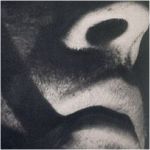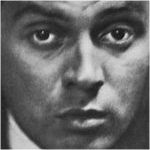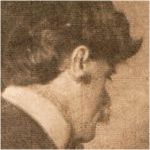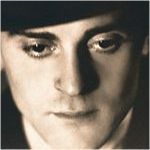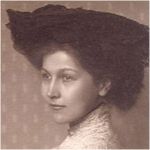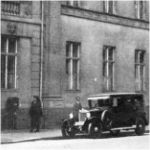
March 25, 2005PHOTOGRAPHY
REVIEW | 'PORTRAITS OF AN AGE'
German and Austrian Glamour Before It Dissolved in World War
IIBy GRACE GLUECK
| "Portraits of an Age:
Photography in Germany and Austria, 1900-1938" will remain on
view at the Neue Galerie, 1048 Fifth Avenue, at 86th Street,
Manhattan, (212) 628-6200, through June
6. |  icture a glamorous
gala attended by beauties, uglies, writers, thinkers, artists, loners,
actors, dancers, politicos, social swans and maybe a dash of royalty, from
the eventful years in Austria and Germany between the turn of the last
century and the Anschluss that preceded World War II. icture a glamorous
gala attended by beauties, uglies, writers, thinkers, artists, loners,
actors, dancers, politicos, social swans and maybe a dash of royalty, from
the eventful years in Austria and Germany between the turn of the last
century and the Anschluss that preceded World War II.
The feast of guests might include the very people depicted in
"Portraits of an Age: Photography in Germany and Austria, 1900-1938" at
the Neue Galerie. The first show there to be devoted exclusively to
photography, this ambitious venture - organized by Monika Faber, curator
of photography at the Albertina Museum in Vienna - presents more than 100
faces, from the poet Stefan George, idolized by the Nazis, to the actress
Elizabeth Bergner and the dancer Anna Pavlova.
The portraits were shot by 35 photographers active in the two
countries, among them Lotte Jacobi, Josef Albers, Gisèle Freund, Laszlo
Moholy-Nagy and August Sander. Sander is famous for his anthology of 540
portraits, classified by social and professional, rather than racial,
type. (Two from that series are in this show.)
The exhibition uses their images not only to give a sense of the rich
cultural life in Austria and Germany - and the personalities who helped
create it - but also to trace the history of photography during the
period.
The changes in the medium were effected not only by progress in methods
- the use of the glacial turn-of-the-20th-century portrait camera vs. the
snapshot-style "candid" devices of later years, for example - but also by
the ways that people perceived and presented themselves as subjects during
an era of rapidly changing social values.
In the early part of the century, few, even among the cognoscenti,
would dream of having a professional photographer capture revelatory poses
or expressions. Tradition prevailed, resulting in stuffy drawing room
studies with subjects in stylized poses, keeping a reserved distance from
the photographer and the viewer.
One of the most striking of these portraits is the photographer Alfred
Stieglitz as recorded by the impressionistic lens of Heinrich Kühn (1904):
a three-quarter profile with Stieglitz partly turned away from the viewer
as he regards a small painting, his full bushy hair touching his collar.
The photograph has a romantic "pictorial" tone, thanks in part to the gum
bichromate method of printing, which allowed for a kind of painterly
fuzziness. The persona is there, but you don't get a real sense of
Stieglitz as a person.
The ultimate in mannered fin de siècle style, however, is Nicola
Perscheid's seated portrait of a Fräulein Sakur (1905), wearing a huge
picture hat and an all-enveloping Victorian gown. She gazes soulfully into
space, her left arm dangling as she holds a book with a finger placed in
it, maybe to mark a swoon-y romantic passage. Perscheid was Berlin's court
and celebrity photographer par excellence, the show's catalog reports, and
this picture suggests why.
But by World War I, the social order was in turmoil, and photographers
and their subjects seemed willing to try new, even experimental
approaches. One result is seen in an emotive portrait by the Czech Antios
(Anton Josef Trcka) of the Expressionist master Egon Schiele (1914). This
dissonant painter, noted for the agitated lines of his often erotic work,
is shown in an intense close-up, his forehead furrowed, concern on his
face, his fingers in front of him nervously clasped in a viselike
grip.
Schiele's mentor, Gustav Klimt, also photographed by Antios that same
year, appears calmer in a captivating djellaba-like smock, bearded and
mustached with tufts of wiry hair sticking out from either side of his
balding head. His broad, sensual face has a staged off-camera gaze.
As silent films gained in popularity, the big close-up became more and
more a feature of still photography, too. The shape and modeling of the
face could almost be designed by the photographer through lighting and
other effects. An extreme example is a picture made by David Feist, a
one-time Bauhaus student noted for his stagey distortions and tight
cropping.
His photograph of one Kurt Stolp (1929) is a stubbly fleshscape, taken
at an angle so you look right up the Stolp nostrils. A pipe projects from
his mouth, its bowl pushing at the picture's very forefront, with the
shadow of the stem streaking diagonally up his face. Dated now, the
photograph must have been a shocker then.
The avant-garde artistic theories advanced by the Bauhaus had their
effect, of course, on photography. The influential Moholy-Nagy, a teacher
at the school in Dessau, experimented with all kinds of photographic
technologies and effects, and his 1926 paired portraits of his wife,
Lucia, exemplify another "extreme" work. A homed-in close-up of part of
her face touched by dramatic shadows, conventionally printed, is twinned
with a silver negative print that exactly reverses the lighting
effects.
Other startling lighting effects were achieved in Jacobi's
below-eye-level view of the actor Franz Lederer wearing a bowler hat
(1930); Marianne Breslauer's angled shot (1930) of the photographer Paul
Citroen's face, with sausagelike shadows cast on it by the fingers of his
spread hand; and the eerie "Grete's Eyes" (1928) by Max Burchartz, an
almost abstract shot in which the shadowed eyes of a woman are glimpsed
through the veil of her hat.
(It's worth noting that Burchartz, a well-known progressive teacher and
theorist of photography in Berlin, was an illustrator of Fascist
propaganda books and joined the Nazi Party after 1937).
Women, as photographers as well as subjects, play an important role in
this show, and rightly so. By the 1920's their social roles had changed
dramatically. A new self-regard was manifest, in behavior and attitudes as
well as in clothing. Compare the languid 1905 view of Fräulein Sakur with
Breslauer's snappy 1934 take on the baroness Maud Thyssen, a race car
driver whose scalp-tight helmet imparts a glamorous dash.
Women now felt free to explore many roles, and to present themselves as
something other than flawless: healthily unkempt, as sensual beings with
erotic overtones, even in disguises (as some men did, too). Photographs
might be of unspoiled youth, like the Bauhaus artist Ettel Mittag-Fodor's
1929 snapshot of a Bauhaus student, Ricarda Schwerin, blond hair blowing
breezily over her fresh young face; or be of worldly exoticism, like the
dancer photographed by Atelier d'Ora in 1922, head thrown back in a wild
nest of hair, breasts partially revealed by her boldly printed gown.
In between these extremes are Marta Astfalck-Vietz's "disguised"
"Self-Portrait" (about 1930), wearing a lace tablecloth that artfully
stops slightly short of her crotch; and a portrait by Yva (Else
Neuländer-Simon) of the back of the head of the silent film star Asta
Nielsen (about 1930), in the kind of close-cropped haircut that signaled
women's emancipation.
An ultrasophisticated 1930 photograph by the Bauhaus graduate Gertrude
Arndt of herself in a veiled mask, saucily regarding the viewer over her
shoulder, is one of the more than 40 playful self-portraits taken by
Arndt, an early Cindy Sherman, of herself in various roles over a period
of a few days.
By way of contrast, the show includes a small group of photographs of
what the Nazis regarded as true German folk, taken from various books
designed to propagandize for the Third Reich's Aryan racial policies. They
include a poet, a blast furnace worker from the Saar, the jolly young
daughter of a fisherman from the Baltic Sea area, and a peasant woman from
East Tyrol, among other types.
But the main difference between them and the other faces here - aside
from their nonaesthetic intent - is the distorted purpose they served. It
puts them at an opposite pole from the dynamic beings that give this show
its edge.
Copyright 2005 The New York Times
Company |

![]() he NY Times did a review of a current exhibition of the work of
German and Austrian photographers done between 1900 and 1938 at a gallery
in New York City. To go along with the review, the reviewer created a
slide show from five pictures, all portraits, from the exhibition that she
liked. They are all interesting, but none of them gives the slightest clue
to the tremendous political crises that wracked those two countries in the
same period.
he NY Times did a review of a current exhibition of the work of
German and Austrian photographers done between 1900 and 1938 at a gallery
in New York City. To go along with the review, the reviewer created a
slide show from five pictures, all portraits, from the exhibition that she
liked. They are all interesting, but none of them gives the slightest clue
to the tremendous political crises that wracked those two countries in the
same period.
